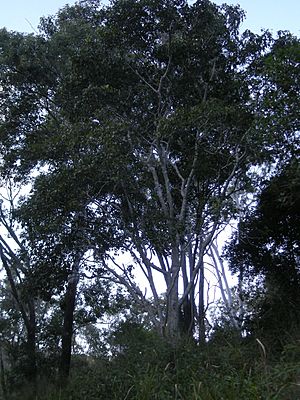Burdekin plum facts for kids
Quick facts for kids Burdekin plum |
|
|---|---|
 |
|
| Conservation status | |
| Scientific classification | |
| Genus: |
Pleiogynium
|
| Species: |
timoriense
|
| Synonyms | |
The Burdekin plum, also known as the sweet plum or tulip plum, is a medium-sized tree that grows delicious fruits. Its scientific name is Pleiogynium timoriense. In the Djabugay language, it's called guybalum. This tree is native to places like Malesia, Australia, and many Pacific Islands.
Contents
About the Burdekin Plum Tree
The Burdekin plum is a rainforest tree that can grow quite tall. It's known as a semi-deciduous tree, meaning it doesn't lose all its leaves at once. In rainforests, it can reach up to 20 meters (about 65 feet) high. When grown in gardens, it's usually around 12 meters (about 39 feet) tall. Older trees might even develop buttress roots, which are large, wide roots that help support the tree's trunk.
Leaves and Trunk
This tree has a thick, full top (canopy) with shiny, dark green leaves. Each leaf is made up of 5 to 11 smaller leaflets. These leaflets are shaped like ovals and are arranged opposite each other. The leaflet at the very end of the leaf has a longer stalk than the others. If you look closely at the underside of the leaflets, you might see tiny bumps called domatia. The tree's trunk has a rough bark.
Flowers and Fruit
Burdekin plum trees are dioecious. This means there are separate male and female plants. Only the female trees produce fruit. The trees have yellowish-green flowers that usually appear between January and March.
The fruit is a round, plum-shaped drupe, about 2 to 3.8 centimeters (0.8 to 1.5 inches) wide. The fruit's skin and flesh are usually a dark purple color, just like a plum. However, some trees can produce white varieties of the fruit. The fruit is safe to eat once it is ripe.
Naming the Burdekin Plum
The first scientific name given to this species was Icica timoriensis. This name was given by Augustin Pyramus de Candolle in 1825. Later, in 1952, a scientist named Pieter Willem Leenhouts renamed it Pleiogynium timoriense. Many other botanists also studied this tree and gave it different names. But today, Pleiogynium timoriense is the official scientific name.
What the Name Means
The name Pleiogynium comes from two Ancient Greek words. "Pleíōn" means "more," and "gunḗ" means "female." This name refers to the many small parts inside the flowers that develop into seeds. The second part of the name, "timoriense", means "from Timor". This is because the very first sample of the tree was collected on the island of Timor.
Where Burdekin Plums Grow
The Burdekin plum naturally grows in many places. You can find it in Borneo, Sulawesi, the Philippines, the Moluccas, New Guinea, the Solomon Islands, the Cook Islands, Tonga, Fiji, New Caledonia, and Queensland in Australia.
It likes to grow in rainforests and monsoon forests. These trees can be found from sea level up to about 1,000 meters (3,280 feet) high. They often grow near rivers and streams. In Queensland, they are found in dry rainforests and along rivers, especially north of Gympie.
Animals That Eat Burdekin Plums
The fruits of the Burdekin plum are a food source for some interesting animals. Large birds like cassowaries and great bowerbirds enjoy eating these plums.
How People Use Burdekin Plums
The Burdekin plum fruit is edible, but it can be a bit tart or sour. Some people find the pale greenish varieties taste better.
Traditional Uses
Indigenous Australians have known about and used this fruit for a long time. They would sometimes bury the fruit underground to help it ripen and become softer and sweeter. The fruit can be eaten raw, cooked, or used to make jellies, jams, and other preserves.
Historical Notes
When Joseph Banks traveled to Australia with Captain James Cook, he collected some Burdekin plums. This was when their ship stopped at the Endeavour River. Joseph Banks wrote that the fruits were "very hard and disagreeable" when first picked. But after a few days, they became soft and tasted "much like indifferent Damsons" (a type of European plum).
Timber Use
The wood from the Burdekin plum tree is quite beautiful. However, it's not often used for timber. This is because it's hard to find large, good-quality logs of this tree.
Gallery







